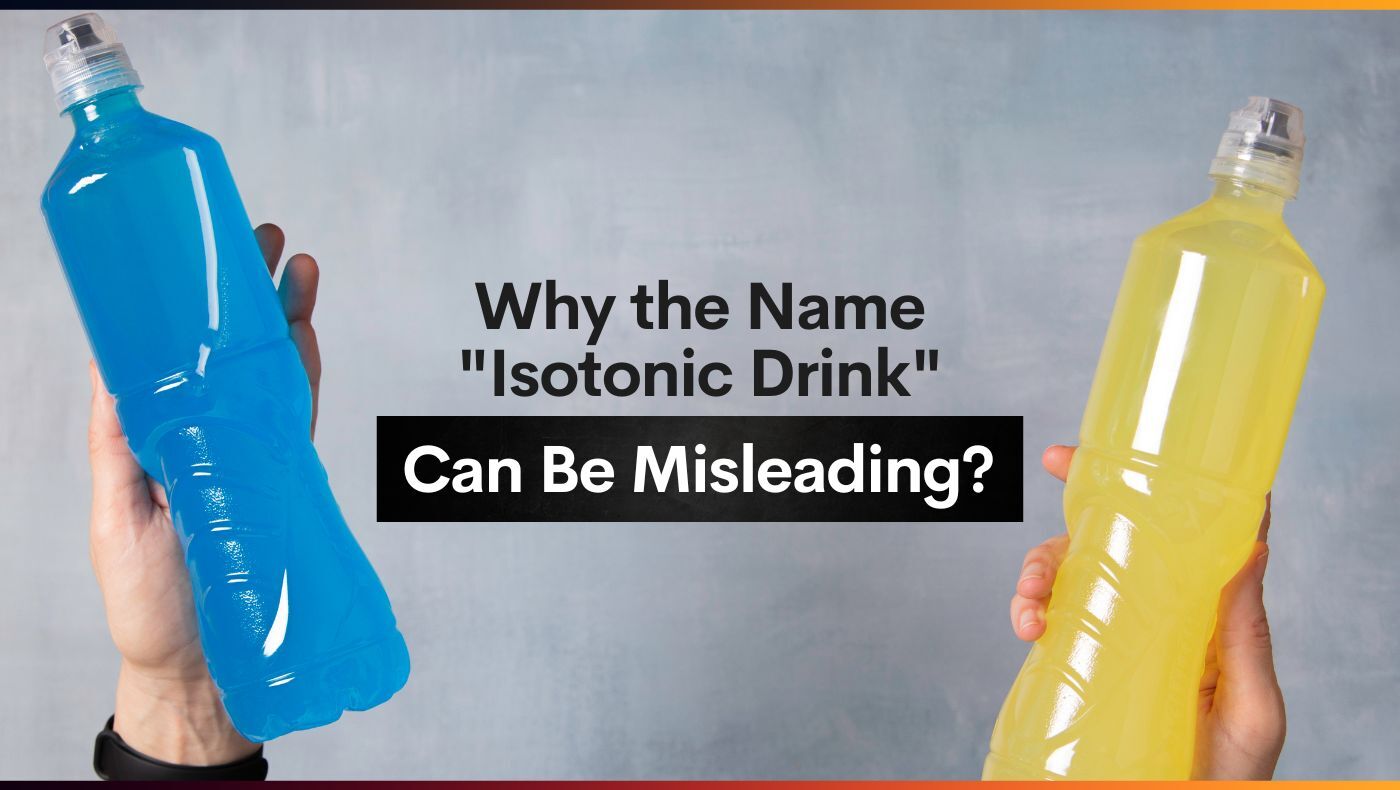Since the term first started being used in the 1980s, isotonic drinks have become the go-to sports drink. They are cited with benefits ranging from rapid rehydration, improved performance, and reduced fatigue (to name just a few).
However, while there certainly is a lot of research to back up the use of drinks containing sugar and electrolytes, the research on isotonic drinks isn’t as clear-cut as the marketers would have you believe.
Let’s break down what an isotonic drink is and whether you actually need to worry about tonicity.
What Is Osmosis and Tonicity?
Before diving into the claims around isotonic drinks, we need to understand two terms: osmosis and tonicity.
Osmosis:
Osmosis is the movement of water particles across a semipermeable membrane (like a cell wall) from an area of higher concentration to one of lower concentration. This process continues until the concentration of particles is equal on both sides.
Imagine this: If you wet one side of a cloth, the water spreads to the dry side. That’s because water moves from the area with more water (the wet side) to the area with less water (the dry side) to balance things out.
In your body, osmosis happens between your cells and the fluids surrounding them. Water moves in and out of cells, balancing the concentration of particles inside the cells with those outside.
Tonicity:
In simple terms, tonicity describes a solution’s thickness compared to the thickness of another solution. The difference in thickness will create osmotic pressure, causing water to move from one to the other until they are balanced.
Tonicity is essential in biology because it helps explain how cells interact with their environment, such as staying hydrated or avoiding too much water loss.
Pro Fact: You’ll often hear the word osmolality being used interchangeably with tonicity, but they are not the same. Osmolality is a measure of all of the particles dissolved in a liquid, regardless of whether they pass through cell membranes. Tonicity only measures particles that can’t pass through the cell membrane, aka impermeable solutes. Glucose and sodium are examples of these impermeable solutes.
Tonicity of Sports Drinks
In regards to sports drinks, tonicity compares the drink’s concentration to the concentration of the human blood. Depending on its concentration, it is labeled as hypotonic, hypertonic, or isotonic.
Hypotonic:
- Definition: The drink has a lower concentration of osmotically-active particles than blood.
- Example: Plain water.
- What Happens: Water will move into the cells.
- Best Use: Hypotonic drinks are useful when you need to rapidly replace lost fluids but don’t need large amounts of energy or electrolytes, such as during short-duration, low-intensity activities.
- Potential Risks: Consuming large amounts of hypotonic solutions (drinking more than you sweat) during prolonged exercise can cause cells to swell. This can be very dangerous, and even fatal in certain scenarios, because cells can burst.
Hypertonic:
- Definition: The drink has a higher concentration of osmotically-active particles than blood.
- Example: Laxatives and, to a certain extent, very sugary drinks, such as Coca Cola.
- What Happens: Water will move from the cells into the surrounding fluids.
- Best Use: When the athlete has high calorie but low fluid needs, such as during carbohydrate loading.
- Potential Risks: This can cause diarrhea.
Isotonic:
- Definition: An isotonic drink matches the concentration of osmotically active particles (like electrolytes and carbohydrates) in blood, enabling efficient absorption.
- Example: Specialty sports drinks designed for endurance athletes.
- What Happens: The concentration of particles is balanced between the inside and outside of cells. This allows water to move in and out at the same rate, keeping cells stable in size. Electrolytes and carbohydrates are absorbed efficiently, providing hydration and energy simultaneously.
- Best Use: Ideal for athletes who need to hydrate and refuel during exercise.
- Potential Risks: While isotonic drinks are formulated to mimic the concentration of particles in blood, they don’t replicate the actual composition of blood. This means they may not fully meet all hydration or fueling needs in every scenario.
Pro Fact: Any other carbohydrates you consume affects tonicity. For example, if you consume a isotonic drink and an energy gel, the contents of your gut could become hypertonic.
Are Isotonic Drinks Actually Better?
The theory behind isotonic drinks is that their components—water, carbohydrates, and electrolytes—will be absorbed more effectively, allowing optimal hydration and fueling.
While this sounds logical and is supported by research, there are several problems with relying on isotonic drinks.
1. Legal Definitions of Isotonic and Enforcement
In Europe, the EFSA regulates the term “isotonic.” For a sports drink to have this designation, it must have an osmolality between 270 and 330 mOsm/kg.
The sports supplement industry isn’t as highly regulated as pharmaceuticals, so it isn’t very surprising that some brands mislabel their drinks. One study sampled 18 sports drinks and found that six didn’t meet the legal definition of isotonic, despite labeling their products as isotonic.
Outside of Europe, the term isotonic is even less regulated. For example, the FDA in the United States still does not have a legally binding definition. As a result, there’s no knowing whether an “isotonic” drink is really isotonic or not.
2. Osmolality and Tonicity Aren’t the Same
Under the EFSA regulations, a product is labeled isotonic if its osmolality is between 270 and 330 mOsm/kg. However, osmolality and tonicity are not the same. Remember, osmolality is the total concentration of particles, whereas tonicity is only the particles that can't pass through the cell membrane (and thus create osmotic pressure).
As a result, a drink could fall under the legal definition of “isotonic” but not actually behave as an isotonic solution in the body.
While osmolality does affect how quickly a solution is absorbed into the intestines (and thus is important for fueling), it is tonicity which matters for cell hydration.
3. Isotonic Drinks Don’t Actually Match Blood
Even if a drink has the same tonicity as your blood, it doesn’t mean it has the same amount of carbohydrates and salts as your blood.
Blood contains a very high amount of sodium but very little glucose. If an isotonic drink were to contain the same amount of salt as blood, the drink would be so salty that it would be unpalatable to drink. At the same time it would contain little to no carbohydrates. As a result, isotonic drinks have higher concentrations of sugar and lower concentrations of sodium than blood has.
To make matters worse, a lot of isotonic drinks contain electrolytes that your body doesn’t need. For example, many sports drinks overdo it with magnesium, which the body doesn’t actually lose much of when sweating.
4. Carbohydrate Type Matters
Tonicity isn’t the only thing that matters when it comes to carbohydrate absorption. There is evidence, for example, that a combination of glucose-fructose is better absorbed than glucose alone–even when the tonicity is the same. This is because the body is able to absorb different carbohydrates using different transporters.
5. Most People Don’t Need Isotonic Drinks
The market for isotonic drinks has grown rapidly, in part because of marketing tactics that imply they hydrate more effectively than plain water. As a result, you’ll see people consuming isotonic drinks during casual activities like walking through the park or a leisurely bike ride.
However, if you aren’t sweating profusely or burning through your energy stores, you probably don’t need isotonic drinks: Plain water is adequate for replenishing fluids. No extra sugars or electrolytes are necessary. In fact, research shows that consuming “isotonic” drinks when not necessary can even cause weight gain in people because of the extra calories.
Isotonic formulations only become useful when a person is sweating profusely and has high fueling needs, such as during high-intensity endurance activities.
A Better Alternative to Isotonic Drinks?
The term “isotonic” doesn’t actually tell us much and often ends up being a marketing ploy rather than a useful designation. Instead of relying on isotonic formulations, endurance athletes should instead:
1. Use the Term Sport Drink Instead
The term “sports drink” is more accurate than “isotonic drink” because it implies purpose: for sports. And sports drinks formations can target athlete’s specific needs. For example, a hypertonic drink may be better when sweat rates are low (such as cold weather) and the athlete wants to prioritize carbohydrate intake.
2. Drink to thirst.
According to Dr. Tim Podlogar, thirst is actually a good indicator of hydration needs. Drinking to thirst will prevent dehydration and hyponatremia. For more, read our Hydration Guide.
3. Fuel Properly
For endurance activities, this generally means consuming 45 to 90 grams of carbohydrates per hour in a 1:0.8 ratio of glucose to fructose. Read more in our Fueling Guide.
4. Consume the Right Electrolytes
Instead of trying to replicate tonicity of the blood, focus on consuming the electrolytes your body actually loses during sweat. The Nduranz Electrolyte Mix contains the same salts lost in 500 ml of sweat.

